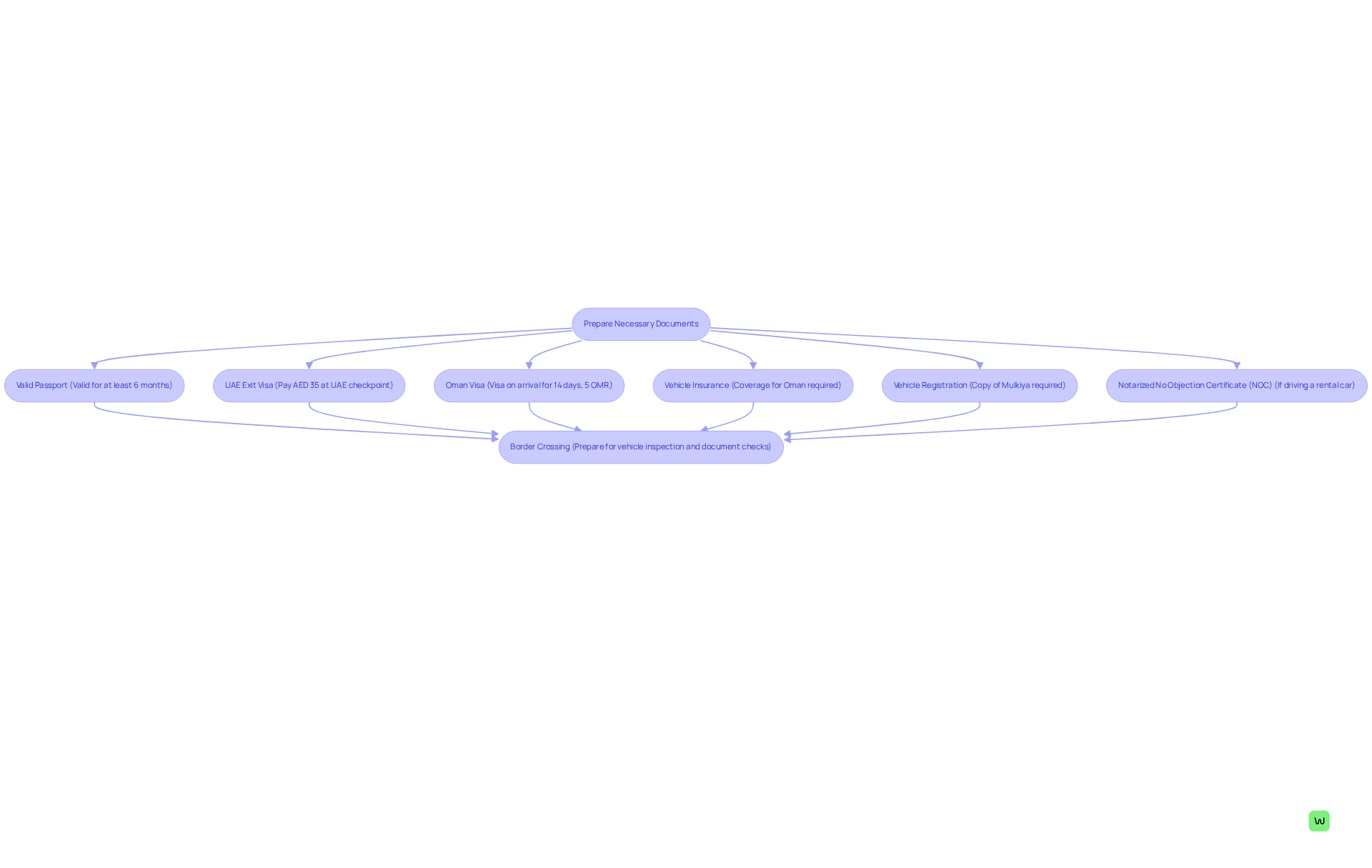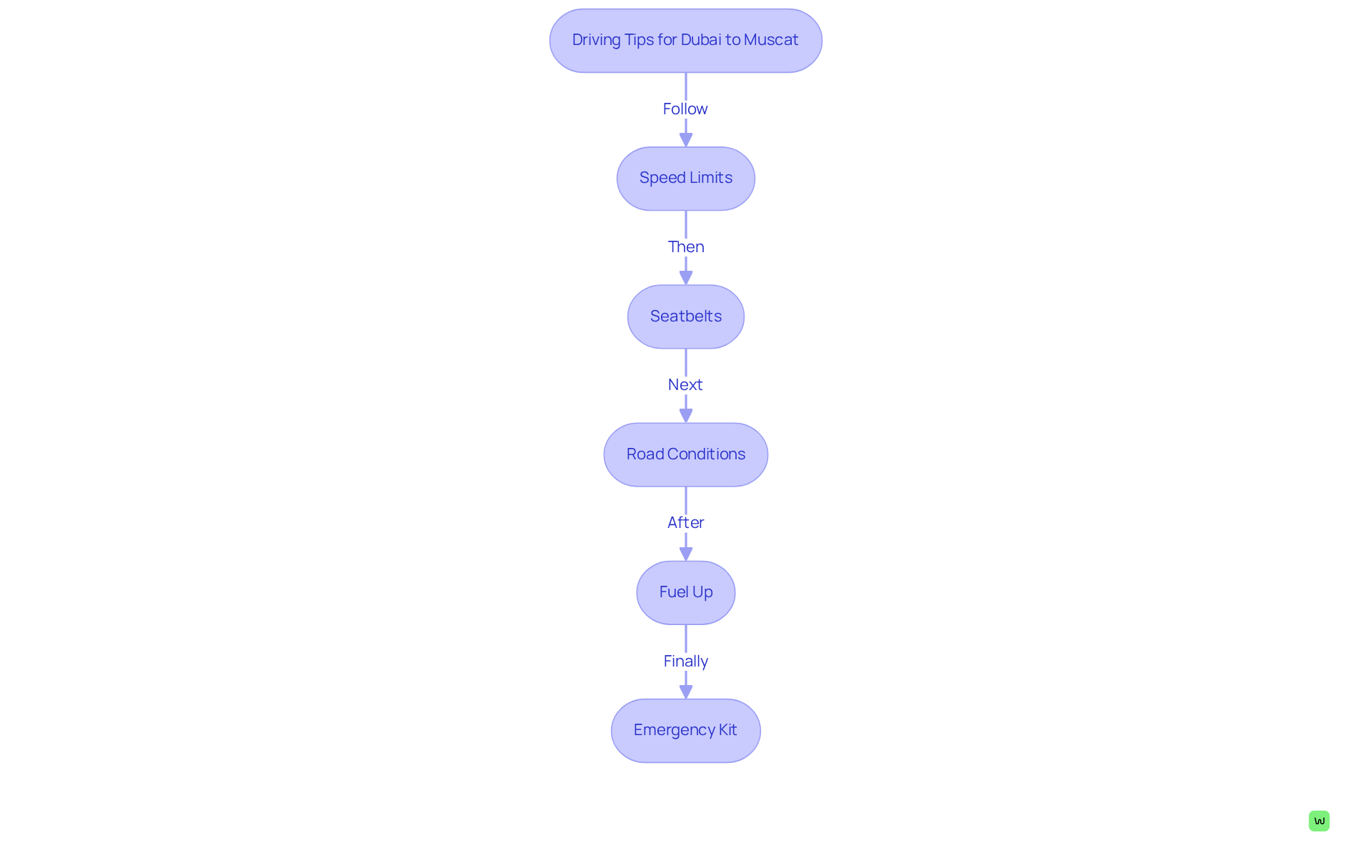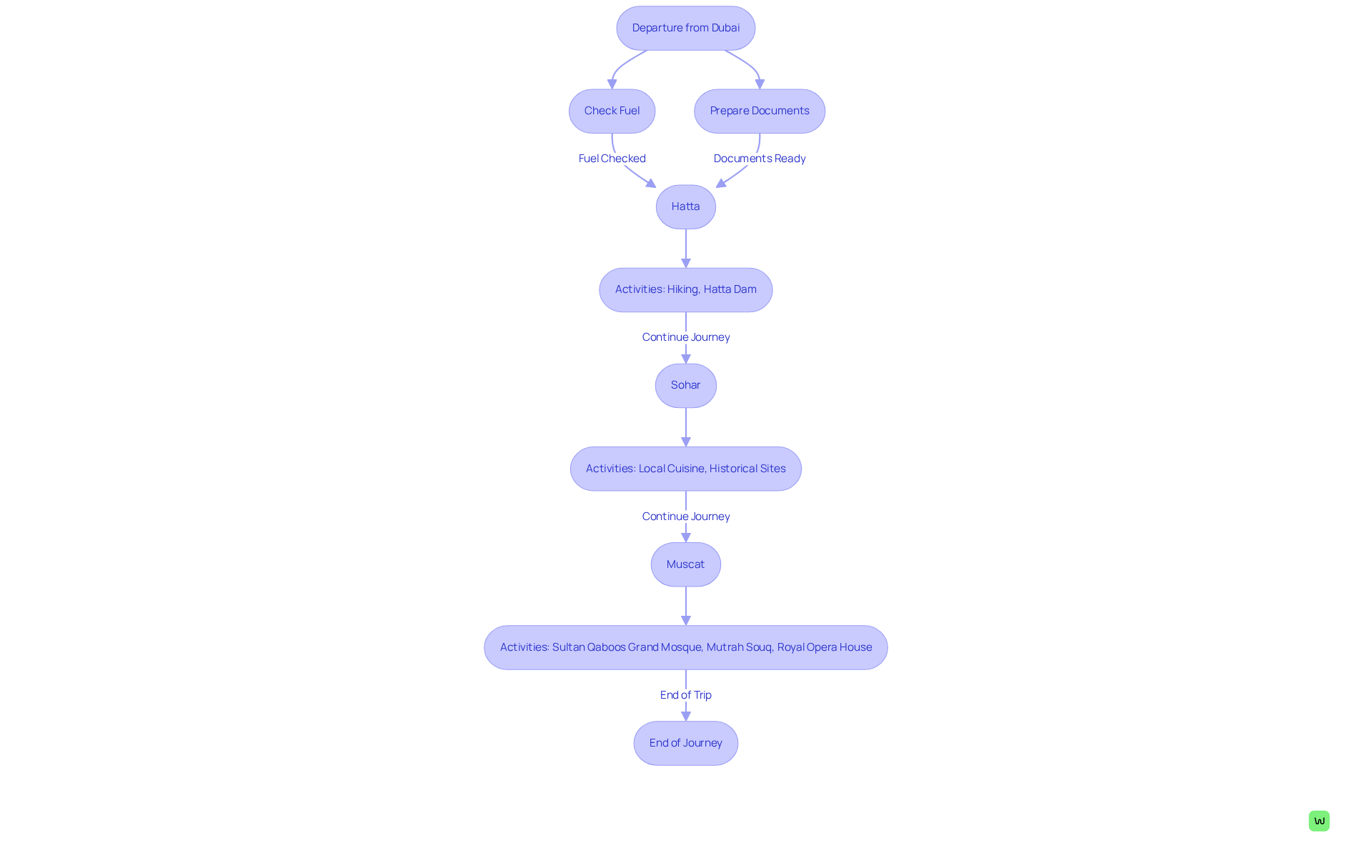Overview
Driving from Dubai to Muscat necessitates meticulous preparation. Are you ready? Essential documents include:
- A valid passport
- An exit visa
- Vehicle insurance
Additionally, selecting an efficient route, such as the Hatta-Al Wajajah crossing, is crucial. Proper documentation and adherence to safety guidelines are not just formalities; they significantly enhance your travel experience. Planning stops along the scenic route can ensure a smooth border crossing while allowing you to enjoy the journey. Prepare wisely, and your adventure will be rewarding.
Introduction
Embarking on a road trip from Dubai to Muscat is not merely a journey; it is an adventure that presents an exquisite blend of stunning landscapes and rich cultural experiences. Travelers must explore essential steps to ensure a seamless crossing, from gathering the necessary documents to selecting the most scenic routes. Yet, with various requirements and potential challenges at the border, how can one navigate this trip effectively while maximizing enjoyment? This guide offers key insights and practical tips designed to make your drive both memorable and hassle-free.
Prepare Necessary Documents and Visas
Before embarking on your journey from Dubai to Muscat, it is essential to have the following documents prepared to ensure a seamless border crossing:
- Valid Passport: Confirm that your passport remains valid for at least six months beyond your travel date.
- UAE Exit Visa: As a UAE resident, you must pay an exit fee of AED 35 at the UAE checkpoint and obtain an exit visa to leave the country.
- Oman Visa: UAE residents can obtain a visa on arrival for a stay of up to 14 days, costing approximately 5 OMR (around AED 50). For extended stays, applying for an eVisa in advance is advisable, as processing typically requires four to five business days.
- Vehicle Insurance: Ensure your vehicle insurance covers driving in Oman. If it does not, a temporary 'Orange Card' can be purchased at the crossing for coverage.
- Vehicle Registration: Carry a copy of your vehicle registration (Mulkiya) to present at the checkpoint.
- Notarized No Objection Certificate (NOC): If you are driving a rental car, a notarized NOC from the rental company is necessary.
Upon arrival at the border, be prepared for a brief vehicle inspection by customs officials before entering Oman. Travelers will need to exit their vehicles for passport stamping and Emirates ID checks. The first checkpoint is located 500 meters from the Oman frontier, where you will present your documents. Having these documents ready will facilitate a hassle-free crossing into Oman, allowing you to focus on enjoying the scenic beauty and cultural treasures that await you.

Choose Your Route and Border Crossing
The Hatta-Al Wajajah crossing is recognized as the most popular and efficient route from Dubai to Muscat, which is located approximately 140 km away. This route not only ensures a swift passage but also presents a breathtaking drive through the Hajar Mountains, solidifying its status as a favorite among travelers. With nearly 2 million travelers passing through the Hatta border crossing annually, its popularity and efficiency are undeniable. Many individuals have praised the picturesque views, with bloggers highlighting the stunning landscapes that enhance the journey. One explorer blogger remarked, "The drive through the Hajar Mountains is simply mesmerizing, with views that make the journey unforgettable."
For those desiring an alternative, the Al Ain/Buraimi crossing offers another option, albeit with a potentially longer travel time. Regardless of the route selected, it is essential to check the border status prior to departure to ensure smooth passage and avoid unexpected delays. The average travel time from Dubai to Muscat via the Hatta-Al Wajajah crossing is approximately five hours. Therefore, planning ahead can significantly enhance your travel experience. Additionally, travelers should be mindful of the exit fee of Dh35 when leaving the UAE and confirm they possess the necessary motor insurance for driving in Oman.

Follow Driving Tips and Safety Guidelines
Driving from Dubai to Muscat necessitates strict adherence to safety guidelines to ensure a secure journey.
Speed Limits: The speed limit on highways is generally set at 120 km/h. With speed cameras widely installed, enforcement statistics reveal that in 2025, over 100,000 fines were issued for speed limit violations in the UAE. This underscores the critical importance of compliance.
Seatbelts: It is mandatory for all passengers to wear seatbelts, reflecting a strong commitment to road safety.
Road Conditions: While the highways are well-maintained, caution is advised for pedestrians and animals, particularly on rural roads where visibility may be limited. Traffic safety authorities emphasize that adherence to speed limits significantly reduces the risk of accidents.
Fuel Up: Before departing, ensure your vehicle is adequately fueled, as fuel stations can be infrequent along the route. The total distance from Dubai to Muscat is approximately 450 kilometers, making it essential to fill your tank in Dubai before departure.
Emergency Kit: Carry an emergency kit, including a spare tire, first aid supplies, and water, to prepare for any unforeseen circumstances.
By adhering to these guidelines, you can enhance your safety and enjoy a pleasant trip from one city to another.

Plan Your Itinerary and Stops Along the Way
To enhance your journey from Dubai to Muscat, consider this carefully curated itinerary featuring essential stops:
- Hatta: Start your adventure in Hatta, where breathtaking mountain views await. Engage in outdoor activities such as hiking or visit the picturesque Hatta Dam for a refreshing experience.
- Sohar: Next, head to Sohar, a charming coastal city ideal for a rejuvenating break. Savor the local cuisine and explore historical sites, enriching your cultural experience along the way.
- Muscat: Upon reaching the capital, immerse yourself in the city's rich heritage. Visit the Sultan Qaboos Grand Mosque, the bustling Mutrah Souq, and the stunning Royal Opera House.
- Timing: The drive from Dubai to Muscat covers approximately 450 kilometers and usually takes around 4-5 hours. However, be sure to allocate extra time for stops and sightseeing to fully appreciate the journey.
Important Considerations: Before departing, ensure your vehicle is filled with petrol, as fuel stations can be limited along the route. Additionally, prepare the necessary documents for crossing into the country, including a Tourism Certificate and vehicle insurance that covers Oman.
By carefully organizing your itinerary and being well-prepared, you can create a memorable road trip filled with exploration and enjoyment, maximizing your journey experience. As travel expert Keri Hedrick notes, "It's a simple process to cross into Oman from the UAE using the Al-Wajajah border point near Hatta.

Conclusion
Embarking on a road trip from Dubai to Muscat presents an extraordinary opportunity for adventure and cultural exploration. With meticulous preparation and an understanding of the necessary steps, travelers can ensure a seamless and enjoyable journey. The foundation of a successful trip lies in gathering essential documents, selecting the optimal route, adhering to safety guidelines, and crafting an itinerary that allows for memorable stops along the way.
Key elements to consider include:
- The importance of possessing a valid passport
- Obtaining the requisite visas
- Ensuring that vehicle insurance extends coverage for driving in Oman
Additionally, the scenic allure of the Hatta-Al Wajajah crossing is noteworthy, as it is favored by many for its breathtaking views and efficient passage. Moreover, adhering to driving safety tips—such as obeying speed limits and carrying an emergency kit—is crucial for a secure journey.
Ultimately, this guide serves as a comprehensive resource for anyone aspiring to drive from Dubai to Muscat. By preparing thoroughly and embracing the journey, travelers can forge lasting memories while discovering the rich landscapes and cultural treasures that await in Oman. Whether for leisure or adventure, investing time in planning and understanding the requirements ensures a rewarding experience on this remarkable route.
Frequently Asked Questions
What documents are required for traveling from Dubai to Muscat?
The required documents include a valid passport, a UAE exit visa, an Oman visa, vehicle insurance, vehicle registration, and a notarized No Objection Certificate (NOC) if driving a rental car.
How long must my passport be valid for when traveling to Muscat?
Your passport must be valid for at least six months beyond your travel date.
What is the process for obtaining a UAE exit visa?
As a UAE resident, you must pay an exit fee of AED 35 at the UAE checkpoint to obtain an exit visa.
Can UAE residents get a visa on arrival for Oman?
Yes, UAE residents can obtain a visa on arrival for a stay of up to 14 days, which costs approximately 5 OMR (around AED 50).
What should I do if I plan to stay in Oman for more than 14 days?
If you plan to stay for more than 14 days, it is advisable to apply for an eVisa in advance, as processing typically requires four to five business days.
Is vehicle insurance necessary for driving in Oman?
Yes, ensure your vehicle insurance covers driving in Oman. If it does not, you can purchase a temporary 'Orange Card' at the crossing for coverage.
Do I need to carry my vehicle registration when crossing into Oman?
Yes, you should carry a copy of your vehicle registration (Mulkiya) to present at the checkpoint.
What is a notarized No Objection Certificate (NOC) and when is it required?
A notarized NOC is necessary if you are driving a rental car, and it must be obtained from the rental company.
What should I expect at the border crossing into Oman?
Upon arrival at the border, be prepared for a brief vehicle inspection by customs officials, and you will need to exit your vehicle for passport stamping and Emirates ID checks.
How far is the first checkpoint from the Oman frontier?
The first checkpoint is located 500 meters from the Oman frontier, where you will present your documents.




